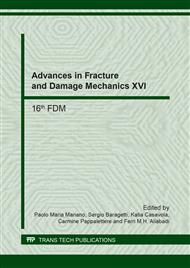p.55
p.59
p.63
p.67
p.71
p.75
p.79
p.83
p.87
Fracture Toughness Characterization of Carbon Bonded Alumina Using Chevron Notched Specimens
Abstract:
A new generation of multifunctional filters is made of carbon bonded alumina and is investigated within the collaborative research center 920 (CRC920). These filters are used during a casting process with the aim of reducing non-metallic inclusions in the cast product. The high thermal and mechanical loading of the filter requires a fracture mechanical characterization of the investigated ceramic material. In order to determine the fracture toughness of the ceramic material, a chevron-notched beam method (CNB) is applied. A 4-point-bending test set-up was constructed and brought into service, at which the load-displacement curve of small chevron-notched specimens (5 x 6 x 25 mm3) can be measured. The set-up offers the possibility of testing specimens at temperatures up to 1000oC. Preceding numerically work using the finite element method was performed to identify a suitable notch geometry. For this purpose a cohesive zone model was used. A parameter study is presented, which shows the influence of the notch parameter on the load-displacement curve.
Info:
Periodical:
Pages:
71-74
Citation:
Online since:
September 2017
Authors:
Price:
Сopyright:
© 2017 Trans Tech Publications Ltd. All Rights Reserved
Share:
Citation:


